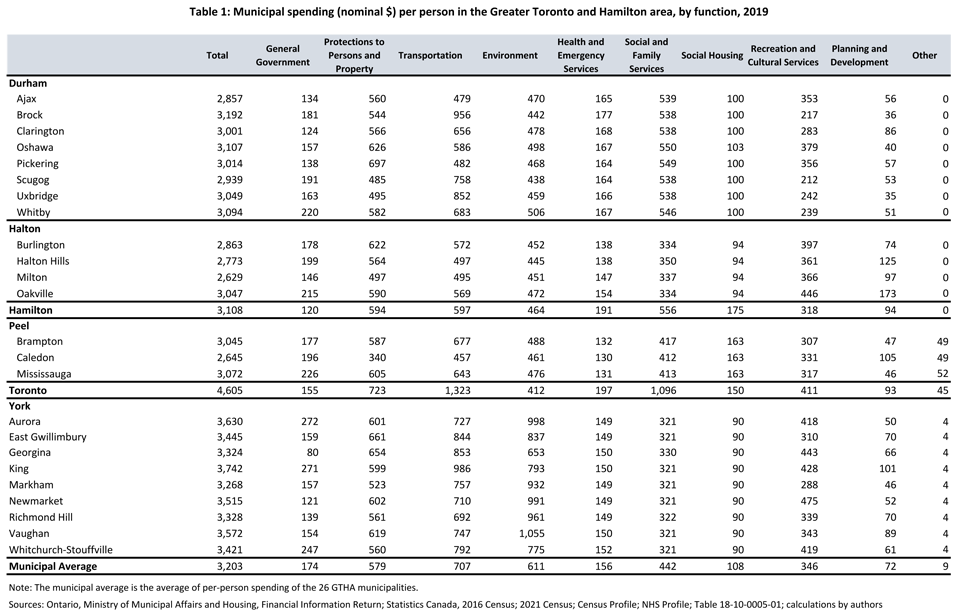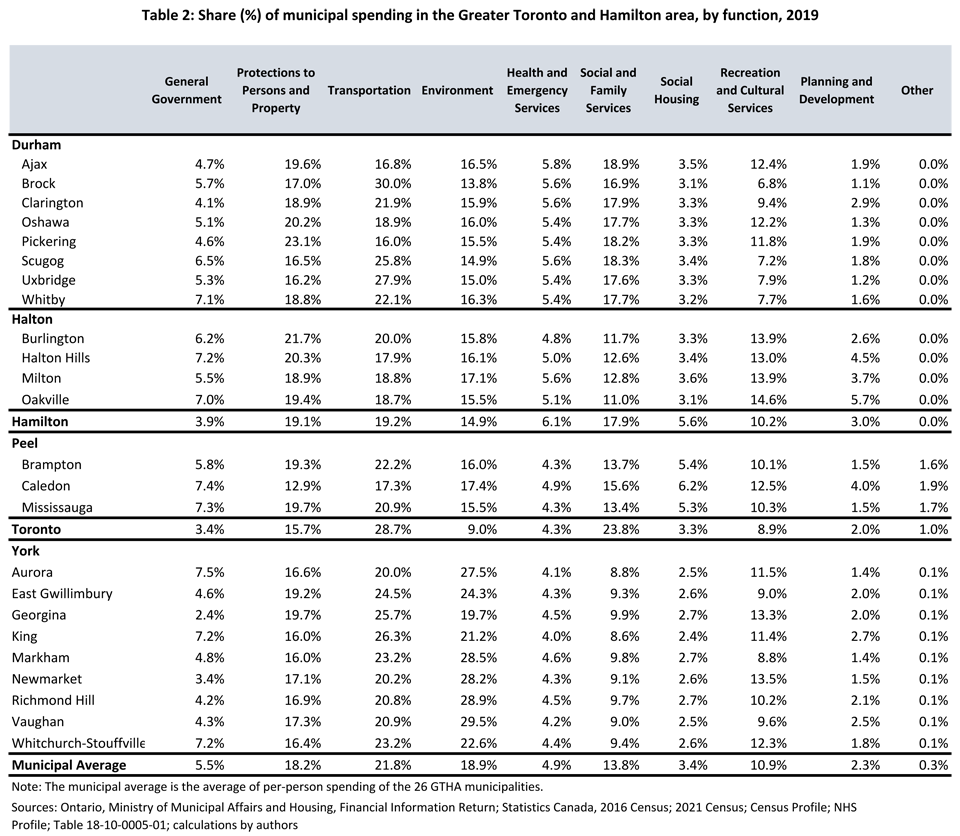Transport top spending category for GTHA municipalities

A recent study documented the level of per-person spending and its growth across the 26 municipalities in the Greater Toronto Hamilton Area (GTHA) for the period 2009 to 2019. This blog post examines the categories of spending by function to better understand the nature of overall municipal spending in the GTHA.
This blog relies on the same data used in the study, which is provided by the Ontario government (see tables at bottom). The data standardize financial information across the municipalities. Information is provided regarding spending on general government, protection to persons and property, transportation, environment, health and emergency services, social and family services, social housing, recreation and cultural services, and planning and development.
Transport is the single largest area of spending by function, averaging 21.8 per cent of total spending across the GTHA municipalities (table 2). Transport includes spending on roads, sidewalks, parking lots, transit and street lighting. The City of Toronto had the highest level of per-person spending on Transport at $1,323 (table 1), which represented 28.7 per cent of total spending in the city, well above the municipal average.
Caledon spent the least on Transport at $457 per person in 2019 while Pickering had the lowest share of total spending (16.0 per cent) on Transport in 2019. Interestingly, the four regions within the GTHA (Durham, Halton, Peel and York) maintained similar shares of total spending on Transport, ranging from 18.9 per cent in Halton to 22.8 per cent in York.
The second-highest category of per-person spending in 2019, on average, was the Environment at 18.9 per cent. Environment spending includes the delivery of wastewater (collection/conveyance, treatment and disposal), urban storm sewer systems, rural storm sewer systems, water treatment, water distribution and transmission, and the collection and disposal of solid waste.
Vaughan by far spent the most per person on the Environment in 2019 at $1,055, almost double the municipal average of $611. It also allocated the highest share of total spending (29.5 per cent) to the Environment. Toronto spent the least on the Environment in terms of per-person spending in 2019 at $412 and the least (9.0 per cent) as a share of total spending on the Environment.
Unlike the spending on Transport, there’s considerable variance between the four regions in the GTHA, Toronto and Hamilton with respect to the share of spending allocated to the Environment. Municipalities in Durham, for instance, on average allocated 15.5 per cent of total spending to the Environment in 2019 while those in York, on average, allocated 25.6 per cent.
Spending on Protections to Persons and Property closely approximates the level of total spending for the Environment, with 18.2 per cent of total spending on average. Fire, police, court security, prisoner transportation, conservation authority, protective inspection and control, building permit and inspection services, emergency measures and the Provincial Offenses Act (POA) are all included this category of spending.
Toronto spent the most per person at $723 on the Protection to Persons and Property, while Pickering dedicated more to this category (23.1 per cent) than any other municipality. Caledon was the lowest spender at $340, also with the smallest percentage of its per person spending (12.9 per cent) allocated to Protections of Persons and Property.
Similar shares of total spending occurred across the four regions, with the highest share of 20.1 per cent in Halton and the lowest in the York Region (17.2 per cent).
The next-highest level of spending as a share of total spending is Social and Family Services, which includes general assistance, assistance to aged persons, childcare and “other” social and family services. In 2019, on average, it represented 13.8 per cent of total spending.
Toronto is both the highest spender at $1,096 per person and dedicated the largest share of per person spending to this category (23.8 per cent), significantly higher than the GTHA municipal average of 13.8 per cent ($442).
Seven municipalities tied for the lowest overall spending on Social and Family Services at $321 per person: Aurora, East Gwillimbury, King, Markham, Newmarket, Vaughan, and Whitchurch-Stouffville. As a per cent of total per-person spending, King spent the least in this category (8.6 per cent).
The lack of variance in both Social and Family Services and Social Housing spending across many regions in the GTHA is a result of most, if not all of the spending being done by the upper-municipality, which means there’s a standardized level of spending across the region. Any small variances between the municipalities in the region are a result of small amounts of independent municipal spending.
The only other category of spending to consume, on average, more than 10 per cent of total spending (specifically 10.9 per cent) is Recreation and Cultural Services, which includes parks, recreation programs, recreation facilities (golf courses, marinas, ski hills, arenas, community centres, swimming pools), libraries and museums.
Newmarket spent the most per person in 2019 at $475 and had the largest percentage of any municipality at 13.5 per cent of its total per person spending on Recreation and Cultural Services. Scugog was the lowest spender at $212 per person while Brock had the lowest share of any municipality for per-person spending on Recreation and Cultural Services (6.8 per cent).
The remaining categories all represent less than 10 per cent of total municipal spending, on average, in 2019: general government (5.5 per cent), health and emergency services (4.9 per cent), social housing (3.4 per cent), and planning and development (2.3 per cent).
The data provided in tables 1 and 2 detail the nature of per-person spending across the municipalities in the GTHA. Like all per-person spending it’s ultimately residents who remain best positioned to determine if they receive value for money in the categories driving municipal spending.
Authors:
Subscribe to the Fraser Institute
Get the latest news from the Fraser Institute on the latest research studies, news and events.



